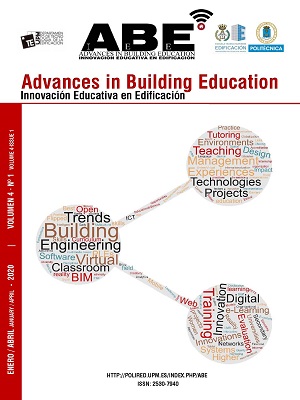On how communication transforms architectural perception. Seattle Library, OMA = De cómo la comunicación trasforma la percepción de la arquitectura. Biblioteca de Seattle, OMA.
DOI:
https://doi.org/10.20868/abe.2020.1.4416Palabras clave:
Communication, Approach, Information, Design, Analysis, Comunicación, Aproximación, Información, Diseño, AnálisisResumen
ABSTRACT
Multiple communicative strategies can be followed in architecture according to the target audience. The mechanisms of representation may radically vary when the recipient is the client, the constructor, the curator, a colleague or even an instructor (1). As an example, the approach may be mainly visual when the target is the client. However, it may be strictly conceptual when pointing to the jury members in a competition. In certain cases, the adaptation of the graphic language to the different scenarios leads to such a distortion on the message that the original project is hardly recognizable. This article will focus on the project of the Public Seattle Library, designed by the architect Rem Koolhaas. The analysis of five different communicative strategies of the project show peculiar and unequal graphic narrations: from the concept book of the competition, the website of LMN (the American partners of Rem Koolhaas- OMA in this particular project), the website of OMA, the coverage on the Seattle press, the Library Brochure for teenagers and the approach developed on the "Content" book. Rem Koolhaas coined the concept of "design of information" to express the fundamental relationship between the message and media in architecture. In his practice, the communicative strategy is present from the beginning of the design process till the final stages. In this article, the thoughtful comparison of these examples will enable to extract conclusions on the use of communication in architectural design and reflect on the iconic and communicative dimension of architecture in general.
RESUMEN
En arquitectura, se pueden seguir múltiples estrategias comunicativas en función de la audiencia a la que estén dirigidas. Los mecanismos de representación varían radicalmente cuando el receptor es un cliente, el constructor, un comisario expositivo, un colega arquitecto o un profesor. Como ejemplo, se adoptaría una aproximación fundamentalmente visual en el caso de dirigirnos a un cliente, mientras que para una comunicación en un concurso, se optaría por una aproximación netamente conceptual. En determinados casos, la adaptación del lenguaje gráfico a los distintos escenarios genera tal distorsión en el mensaje que el proyecto original resulta prácticamente irreconocible. El artículo se centra en el proyecto de la Biblioteca Pública de Seattle, diseñado por Rem Koolhaas. El análisis de cinco estrategias comunicativas distintas nos muestra narraciones gráficas casi antagónicas. Desde la propuesta del concurso, la web de LMN (los socios americanos de OMA), pasando por la propia web de OMA, la cobertura en prensa o el folleto informativo de la propia biblioteca, Rem Koolhaas muestra la especial relación entre el mensaje y el medio en arquitectura, acuñando el término “diseño de la información”. En su trabajo, la estrategia comunicativa se encuentra presente desde el inicio del proceso de diseño y hasta los estadios finales. Mediante la comparación analítica de los distintos ejemplos se podrán extraer conclusiones del uso de la comunicación en el diseño arquitectónico y su reflejo en la dimensión icónica de la arquitectura.
Descargas
Referencias
Bateson, G. (1972), “Steps to an Ecology of Mind”, Jason Aronson Inc., San Francisco.
Matter, S. (2003) How Public Is the Seattle Public Library? Publicity, Posturing, and Politics in Public Design”. Journal of Architectural Education, Vol. 57, No. 1, pp. 5-18.
OMA, Koolhaas, R., (2004) “Seattle Public” in Content, Germany, Taschen, pp.138-149
Seattle Public Library. “Concept Book for the New Central Library”. Accessed May 1, 2016. http://www.spl.org/locations/centrallibrary/cenbuilding-facts/cen-omalmnconceptbook
LMN Architects. “Seattle Public Library”. Accessed May 1, 2016. http://lmnarchitects.com/project/seattlecentrallibrary
Venturi, R., Izenour, S., Scott Brown, D. (1978). “Aprendiendo de Las Vegas (El simbolismo olvidado de la forma arquitectónica)”. Barcelona: G. Gili.
Butragueño, B. (2015). “Rem a los dos lados del espejo”, PhD diss., Polytechnic University of Madrid.
Mushamp, H. (2004), “Interacción explosiva. Una biblioteca de Koolhaas en Seattle”. Arquitectura Viva, nº 96, 2004, p. 79.
Descargas
Publicado
Número
Sección
Licencia
ABE (Advances in Building Education / Innovación Educativa en la Edificación) no aplica cargo alguno a los autores por procesar o publicar un artículo y provee acceso abierto (Open Access) inmediato a su contenido. Todo el contenido está disponible gratuitamente sin cargo para el usuario o su institución. Se permite a los usuarios leer, descargar, copiar, distribuir, imprimir, buscar o vincular a los textos completos de los artículos, o utilizarlos para cualquier otro propósito lícito, sin pedir permiso previo del editor o el autor. Esto está de acuerdo con la definición de acceso abierto de la BOAI.
1. Los autores conservan los derechos de autor y garantizan a la revista el derecho de una Licencia Creative Commons Atribución / No Comercial / No Derivadas 4.0 Internacional (CC BY NC ND) que permite a otros compartir el trabajo con un reconocimiento de la autoría y uso no comercial.
2. Los autores pueden establecer por separado acuerdos adicionales para la distribución no exclusiva de la versión de la obra publicada en la revista (por ejemplo, situarlo en un repositorio institucional o publicarlo en un libro).
Salvo indicación contraria, todos los contenidos de la edición electrónica se distribuyen bajo una licencia de uso y distribución “Creative Commons".














